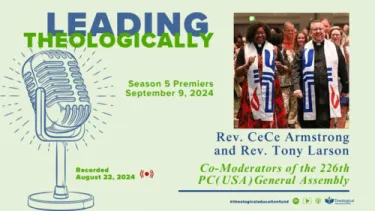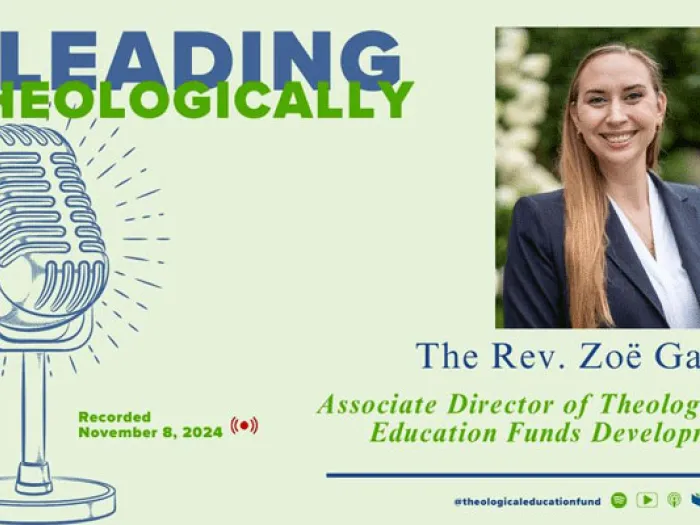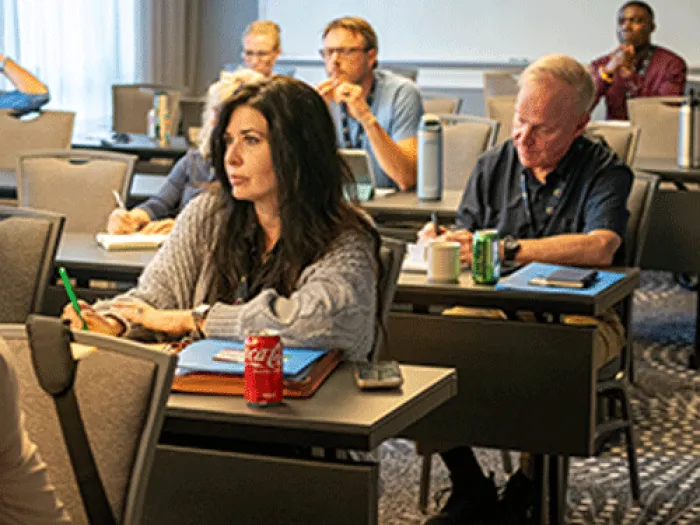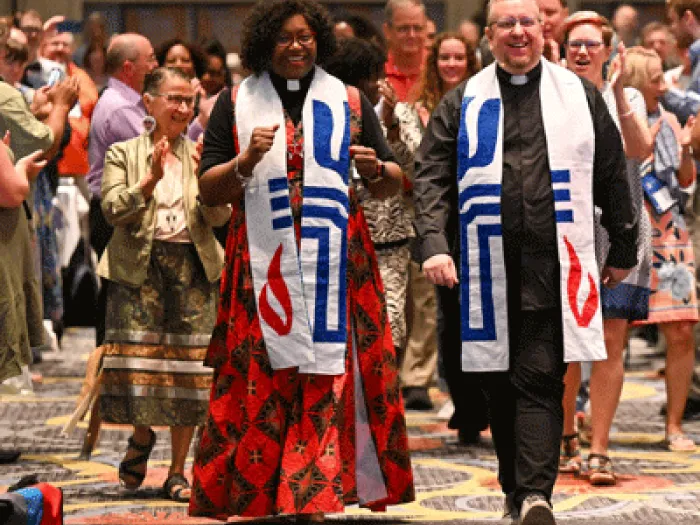Reboot of ‘Leading Theologically’ taps into the Co-Moderators’ wisdom, relationship and energy
The Rev. CeCe Armstrong and the Rev. Tony Larson speak with the podcast’s new host, the Rev. Bill Davis


LOUISVILLE — As the new host of “Leading Theologically,” the Rev. Bill Davis invited the Co-Moderators of the 226th General Assembly to pull their chairs close to the microphone for what would be a 34-minute wide-ranging conversation.
Davis, the Senior Director of Theological Education Funds Development at the Presbyterian Foundation, told the Rev. Tony Larson and the Rev. CeCe Armstrong his first day on the job was July 1, the same day commissioners to GA226 voted them into the denomination’s highest elected office.
“I was so impressed by the ways y’all handled this General Assembly — the humor, the humility, the dancing and the deep connection with our bodies,” Davis said.
Larson pointed out that after being elected on a Sunday night, the two were called to begin moderating the following morning.
“Office of General Assembly staff did a lot to try to help prepare us and walk us through some of the technical pieces [of moderating],” he said. “But the prayerful preparation for doing the work was built around the relationship CeCe and I sought to build as we got to know one another,” including “trying to learn where our different gifts are, utilizing those gifts for the benefit of the body — and a lot of reliance on the Holy Spirit.”
The two used the CAR acronym — for communication, alignment with God’s will and relationships — as “the foundation for all of this work,” Larson said.
While the two are members of adjacent presbyteries in South Carolina, they hadn’t known each other long before announcing they’d stand together for Co-Moderator. “We immediately established a relationship that I am very proud to say I will never let go of as long as I breathe upon this Earth,” Armstrong said. “The relationship is what allows us to do the work that God has called us to do.”
“The biggest piece was the alignment with God — this reliance on God being able to direct our words, our actions and our deeds,” she said. From the platform at the Salt Palace Convention Center, the home of the in-person portion of the Assembly, “we couldn’t hear the murmurs and the discussion because everybody wasn’t mic’d. … So we really truthfully had no other choice but to rely on the presence of the Holy Spirit, who guided us holistically in every aspect as we cared for the General Assembly and for each other, which we could do because we had that relationship.”
It also helped, she said, that the newly elected Co-Moderators had a stellar crew behind the scenes as well as sage advisors on the platform.
“During some of the moments when I moderated, Tony was very observant of what was happening with me. He might have brought me something to drink or just stood beside me to let me know his presence was there,” Armstrong said. “Vice-versa when Tony was up and I thought he was sweating, I’d get a towel and hand it to him. Building that relationship and camaraderie that we wanted for each other was important because of the work but also because we wanted others to see it at work.”
“Our call was a journey to stand,” she said, “but now we’re on a journey to serve.”
Davis recalled Armstrong moderating while “a particularly contentious conversation was taking place. You invited us to do some deep breathing to get out of our heads and into our bodies.” He also recalled Larson helping the body to breathe easier “through your disarming manner of joking with us as an Assembly. I give God thanks for the ways y’all have been formed as leaders for such a time as this in our denomination.”
The Co-Moderators shared some of their travel experiences date, as well as appearances planned for the coming weeks.

“I love the way you’re describing the collaborative journey. The days of isolation and siloization are hopefully long gone,” Davis told them. He recalled that as a seminarian at Columbia Theological Seminary, course offerings at Johnson C. Smith Theological Seminary and the Interdenominational Theological Center allowed him to take classes in womanist biblical interpretation, “so I could learn differently how to be a pastor and a leader in God’s church.”
“We have to lead and learn with others to do this work of ministry,” Davis said.
When Larson thinks about leadership in the church, “more and more I find it’s trying to hold together the community of disciples God has gathered in this place in a time of deep polarization — to attend to their needs while feeling the need to push them outside the sanctuary to neighbors and their real problems, to provide charity and listen deeply to figure out what we need to do to make our neighborhood a more graceful and just place for all who live here.”
It's about balance, Larson said — the “internal life of fellowship and the fundamentals of how healthy our congregation is looking … and how faithful we are being in our theological reflection, our missional engagement and our social witness and advocacy.”
Seminarians may begin by learning to exegete biblical passages like “Love your neighbor as yourself,” but “coming out of seminary, I think you need to be able to read that backwards,” Armstrong said. “How are you first caring for yourself?” Self-care leads to better care of neighbors, she said. “Once I see I can help my neighbor, then I’m very clear that I love God, because you can’t do those things with all the turmoil and dysfunction in our lives without having a reason to do it.”
That verse “is in Greek,” she said, “but maybe we should read it like it’s Hebrew and start at the other end.”
“Friends, we don’t do this alone. We don’t lead by ourselves. We lead with one another,” Davis said. “We lead with God’s grace and mercy and steadfastness.”
“I give thanks for your work as Co-Moderators of our denomination,” Davis said, “and pray for God’s blessing on your lives as you move and travel and lead faithfully, theologically and groundedly in this world.”
Listen to Davis’ conversation with Larson and Armstrong ">here. Learn more about the work of the Theological Education Fund here.
You may freely reuse and distribute this article in its entirety for non-commercial purposes in any medium. Please include author attribution, photography credits, and a link to the original article. This work is licensed under a Creative Commons Attribution-NonCommercial-NoDeratives 4.0 International License.




